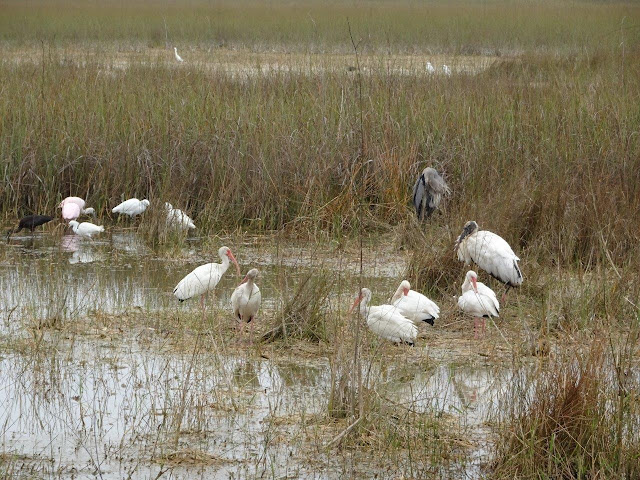This is what the loop trail looks like. Not many bike riders in the morning, especially when it is foggy.
A great white heron greeted me.
This is a hunched over little blue heron. He has a long neck and long legs, but they don't show up when it is sitting on a tree branch.
An adult tri-colored heron. I have trouble distinguishing these from great blue herons because they are about the same size, but this one has a white breast and a little brown on him.
And here comes the tram!!! They are noisy and scare some of the birds away.
And a pair of wood storks just standing around.
I got some good video of what I call the wood stork dance. Click here to open it.
Another wood stork a couple of hundred feet away. This one was next to the road and not happy when a pair of bike riders rode by.
There were a lot of alligators, as usual. The day started out foggy and then turned sunny, so more alligators came out in the afternoon. I probably saw 30-40 alligators today.
Another section of the east side of the loop. This side is curvy and does not get as many people riding past, so it is quieter.
What in the heck is this?? The curved beak shows it is an ibis. I think it has to be a juvenile glossy ibis, but it looks almost black.
Ah, one of my favorite Florida birds--a roseate spoonbill. They are slightly pink because they eat shrimp.
This is an excellent view of this one's spoonbill.
These birds below really aren't Everglades birds, but they do hang out just about everywhere along the southern coast of the U.S. The top bird is a female great-tailed grackle, and the bottom bird is the male great-tailed grackle. Some people call them the parking lot birds because they are often found in parking lots. They are especially noisy and have a repertoire of sounds--chirps, tweets, whistles, cheeps, and everything in between. During breeding season, the males do everything they can to impress the females, so are funny to watch. They strut, bow, fluff their feathers, raise their wings, and dance around, etc. If they could turn somersaults, they would!!!
Smallish bird with black beak, black legs, and yellow feet makes it clear that this is a snowy egret!!
Whoever said only birds of a feather flock together??? There are wood storks, ibises, a glossy ibis, and roseate spoonbills getting along nicely in this tiny pond.
Made it to the tower and looking along the straight west loop.
And a view of the more curved east loop.
One of several yellow-crowned night herons that were sitting in a tree. These are small birds with short legs, so stand out among the long-legged herons and ibises.
This little flock puzzled me until I looked them up. They are juvenile white ibis. I am guessing they are last year's chicks. They must be from the same nest because they really stuck together.
I think these are mud turtles.
This is an American bittern. It has almost no tail and a short neck.
A green heron, obviously, since this is the only heron which is green. He is smaller and shorter than a lot of the other herons, and rarer, so I was happy to see him.
Same bird, but all puffed up so you can see his green feathers better. I watched him walk along the edge of the creek for quiet a while.
I rode my bike almost 16 miles and spent four hours here today! I saw a lot of birds, but it really pays to go slowly and stop to just look sometimes. A lot of birds were semi-hidden in the shadows, so not easy to see if you weren't paying attention.




































































